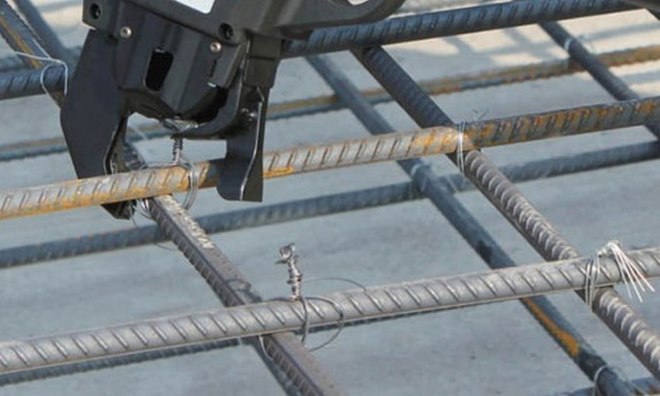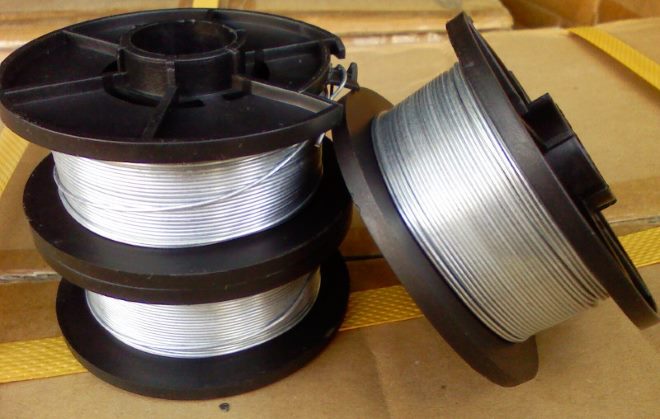The weight of the wire is of little concern to most of its consumers, because they purchase this metal product based on the required footage and, in fact, also pay by meters. But this applies only to those who directly use this product and, moreover, in small quantities. But there is another category of consumers - large construction, industrial and manufacturing enterprises, as well as suppliers who either use or sell wire in large volumes, and for them knowing its weight is essential.
1
Any wire is supplied in coils or coils. And someone needs to know their weight. Let's say, if you need to transport a certain number of bays with a known required footage. After all, the choice of the type and carrying capacity of the vehicle for delivering the wire to its destination will depend on their total weight. But for some it is important to know the mass of 1 m of this type of metal product. For example, for designers to take into account the weight of the wire in the total mass of the structures or products they design.
Any wire is supplied in coils or coils
And also for the same carriers of these metal products, in order to recalculate the known quantity of shipped meters into kilograms or tons. Obviously, it is enough to know 2 of the above 3 characteristics of the wire in order to calculate the one that is unknown and needed. For example, if there is data on the mass of 1 m of wire and the total footage of one or all coils, then their total weight can be calculated. And if the last parameter and the total footage or weight of 1 m are known, then you can calculate the weight of 1 meter or the total length, respectively.
All these calculations fit into the formula: M = L * m, where
- L – total length of wire (for example, in a coil or a whole batch), m;
- M – total mass of wire of length L, kg;
- m – mass of 1 m, kg.
And if you need to calculate m, then m = M/L, and when L, then L = M/m.
2
Most often, it is still necessary to determine the weight of 1 m, since manufacturers and then suppliers of wire ship it in meters (indicating the length of individual coils or coils and the total footage) or in kilograms and even tons. In the latter case, as a rule, the total mass of the entire supplied lot is indicated. And then in the first delivery option it is necessary to find out the total weight of the wire received, and in the second - the total length (batch or coils and coils after weighing them). And this can be done using the above formulas, only by first determining the mass of 1 m.

The easiest way to find out the weight of the wire is by weighing it
The most accurate and trouble-free way to determine the weight of 1 m of wire is to weigh a piece of it of that length. And the simplest, but not always effective, is to look at the tables of manufactured standard sizes (diameters) of the corresponding GOST or reference manual. And the third way is to calculate it yourself using the measured diameter. This option is inferior in accuracy to the first, but may be preferable to the second, and in terms of speed of execution it most often surpasses both of these, but only if we are talking about ordinary wire (just round section), not prickly.
The indicated characteristics for the listed methods arise from the nuances that can be encountered when choosing one or another way to determine the mass of 1 m of wire. As for the first method: weighing is not always possible or it is associated with certain difficulties and takes a lot of time. Regarding the second, the following should be noted. It is not always possible to have the necessary GOST, reference book, or the ability to find them on the Internet. And even if found required document, then not all will contain the required information - weight 1 m. The fact is that not all GOST standards (not for all types of wire) indicate this characteristic.
And the last point regarding the second method - in standards and reference books, if the mass of 1 m is given, it is theoretical. That is, calculated based on the nominal diameter of this product and some average density of the metal from which it is made (for steel products - 7850 kg/m 3, copper - 8890 kg/m 3, and aluminum - 2703 kg/m 3). And the actual thickness may differ from the nominal thickness regulated by GOST within the tolerances established by the same standard. And the alloy from which the wire is made may have a density different from that used in the calculations. This means that the actual mass of 1 m will differ from the table one.
To implement the third (calculated) method, it is enough to simply know or measure the diameter of the wire. Well, and, of course, you need to know what metal it is made of (steel, copper or aluminum). Then, using this data, you can use a wire weight calculator (on the Internet). Or calculate the mass of 1 m independently using certain formulas. How to do this will be described below. It is easy to guess that the calculation method will also not give the exact actual weight. In this regard, it has the same flaws as when determining this characteristic according to GOSTs. That is, the diameter “walks” along the entire length of the product, and the density of the metal may differ from that used in the calculations.
But thanks to this drawback of the calculation method, you can safely not take into account any coatings on the wire (zinc, polymer, enamel) when calculating. After all, their thickness compared to the diameter of the calculated product will always be negligible. And therefore, the above error will “absorb” the one caused by neglecting the coating. That is, it is still unknown which calculation will be more accurate (closer in value to the actual weight of 1 m), since the maximum tolerances for deviation from the nominal wire diameter are significantly greater than the thickness of any coating, which, by the way, also varies in value in a certain range, according to the corresponding GOST. And, in addition, the density of most coatings is less than that of the wire metal.
And one more point, which for the majority of those dealing with this rolled metal indicates against taking into account the mass of the coating when calculating its weight. Determining the thickness of a thin coating is very difficult and even labor-intensive process. And the subsequent separate calculation of the mass of the coating and the core of the product also significantly complicates the calculations, again giving only approximate results of the weight of 1 m, and subsequently of the skein (roll) and the batch. Therefore, for all products (including galvanized, enamel-coated, polymer-coated) it makes sense to use one calculation method - used for uncoated products.
The exception is copper and aluminum electrical wires in insulation. For them, the coating, the insulating shell, must be taken into account, since it has an impressive thickness.
3
Steel wire is, after all, in greatest demand for construction, industrial production, general economic and other needs. Therefore, the masses of 1 m of the most common diameters are given below for it. Moreover, these data are taken from GOST standards, and it does not matter what type of product it is (wire rod or some other), but the weight of steel products of the same diameter will be the same..
For copper and in GOST standards the mass of 1 m is not indicated on them. But how to calculate it will be discussed in the next chapter.

The tabular mass of wire is taken from GOST standards
There is also no data on its mass per 1 m in the standards. But a number of Internet sites provide the following information about this characteristic. For uniaxial (with one wire at the base) “spines”:
|
Characteristics |
Type of single axis barbed wire |
||
|
Galvanized KTs-1 with base wire with a diameter of 2.8 mm, produced in accordance with GOST 285-69 |
Type AKL (species: Gyurza, Cossack, Egoza, Forget-me-not) |
Type ASCL (species: Gyurza, Cossack, Egoza, Forget-me-not) |
|
|
Weight 1 m, kg |
|||
|
Linear meters per bay |
|||
|
Coil weight, kg |
|||
For a biaxial galvanized “barb” (based on a twist of 2 wires), produced according to TU U 27.1-136-001-2002:
|
Diameter of base strand wires, mm |
Wire diameter of spikes, mm |
Standardized distance between two adjacent spikes, mm |
Total weight of 1 m of product, kg |
4
It should be noted right away that it is theoretically possible, of course, to calculate the mass of barbed wire, but in practice it is extremely difficult. And even if you give a calculation method, it is unlikely that any of the visitors to this site will decide to use it. Therefore, below are calculation methods only for products of regular circular cross-section without any additional elements on it (like thorns and others).

When calculating the mass of the wire, an adjustment is made for its density
The mass of 1 m of any such “ordinary” wire can be calculated using the following formula: m = P*D*D*G/4, where
- m – theoretical (calculated) weight of 1 meter, kg;
- P – constant (constant value) equal to 3.14;
- D – it’s already clear that the diameter of the wire, m, needs to be measured;
- G is the density of the wire metal: usually in calculations it is taken for steel - 7850 kg/m3, copper - 8890 kg/m3, aluminum - 2703 kg/m3.
For more accurate calculations, find out the grade of the alloy. Then they find out from GOSTs or reference books its density, which may differ from the values given above. And only then do the calculations. In addition, for products made of aluminum and copper alloys, a calculation can be made using data on the mass of 1 m steel wire(including those indicated in the table above). To do this, use the following formula: M = MS/QС * Q, where
- M – weight of 1 m or aluminum, kg;
- MS – weight of 1 m steel, kg;
- Q – either aluminum: 8890 and 2703 kg/m 3, respectively;
- QС – steel density: as indicated above, 7850 kg/m3.
And one more way of calculation. When the mass of 1 m of a product of any diameter is known, and no matter what metal it is made of, then you can always calculate this characteristic for wire with a different thickness and from a different alloy. This is easiest to do if the material of the product with a known weight and the wire being calculated are identical (both products are made of steel, copper or aluminum). Then it is enough to use the formula: MP = mп/K, where
- MP – estimated mass of 1 m of a product of the required diameter from any metal, kg;
- mп – known mass of 1 m of wire of any diameter from the same alloy, kg;
- K is the coefficient that is calculated: K = k * k, where k = DI/DN (DI is the diameter of the wire with a known mass of 1 m, DN is the thickness of the product for which the weight of 1 m is calculated).
If the metals of the wire with a known mass and the one for which the weight of 1 m is calculated are different, then after this calculation it will be necessary to additionally make an adjustment for the density of the metal. That is, carry out the calculations that were already given above before this method (using the formula M = MS/QС * Q).
The so-called knitting wire is used to create a single frame from individual reinforcement elements, which is used for strengthening reinforced concrete structures. In fact, such a product, used for and manufactured in accordance with the requirements of GOST 3282-74, is one of the types of rolled metal.
The feasibility of using steel wire for tying reinforcement
Wire of various diameters, which is produced in accordance with the requirements of GOST 3282-74, has a general purpose. The material for its manufacture is low-carbon steel. Depending on the purpose, the wire can be additionally subjected to heat treatment, its surface coated with a protective layer of zinc, and manufactured with normal or increased precision. Nails are made from general purpose wire, different kinds fencing. It is also used for tying.
The name of the knitting wire is due to the fact that it is most often used specifically for fixing several elements various designs strapping method. For this purpose, this product is most often used in construction - to create reinforcement frames. must be soft enough, so it is additionally annealed so that it bends better and breaks less when bent.

Using soft annealed wire it is much easier to make a knot that will reliably fix the reinforcement in any spatial position. It is for reasons of ease of bending that products with a diameter in the range of 1.2–1.6 mm are used for tying reinforcement. Due to its small diameter, such wire is easily knitted, allowing you to make various knots on the reinforcement frame.
The diameter range indicated above is optimal, since thinner wire will often break, and thicker wire is more difficult to work with: it does not make it possible to make a strong knot and, accordingly, ensure high reliability of the strapping. The choice of binding wire with or without zinc coating depends only on how durable the connection of the reinforcement frame elements for a concrete structure should be.

An alternative to connecting reinforcement elements with binding wire is welding, which is used to mount metal parts can be done much faster. Meanwhile, it is possible to obtain high-quality and reliable connections of reinforcing bars only thanks to resistance welding, which requires special equipment and the experience of a qualified specialist.
If you use conventional electric arc welding for these purposes, you can overheat the joint, as a result, the reinforcement will become more fragile and may break under the influence of significant loads. Concrete structures, the reinforcement frame of which is connected using electric arc welding, are not highly reliable, since they are not able to withstand long-term and peak loads.
If the conditions for installing the reinforcement frame do not provide for the use of welding, its elements are fixed to each other using binding wire. It is also important that high-quality tying of knots does not require high qualifications, and you can learn how to correctly perform such a procedure very quickly. Quality control of this work is also quite simple; to carry it out, it is enough to check whether all nodes of the reinforcement frame have been strapped.
Main product parameters
The wire used for tying reinforcement for concrete can be supplied to the customer in coils or wound on spools. In this case, the weight of such a skein or reel is specified by the requirements of the regulatory document. Thus, the standard states that the minimum weight of a skein or reel in which wire with a diameter of 1.1–2 mm is supplied should be:
- 2 kg (if the product has a zinc coating);
- 8 kg (without zinc coating).

The consumer, by prior agreement with the manufacturer, can order skeins whose weight will be 0.5–1.5 tons. Only one piece of the product can be wound onto skeins of binding wire for reinforcement, regardless of their weight. Unlike skeins, spools can contain up to 3 such sections.
The shipping documents for a batch of binding wire for reinforcement indicate only the weight, and the length can only be determined approximately. The standard does not stipulate this parameter, and determining the length of the product in a coil or on a reel is also made more difficult by the fact that even the regulatory document states that the diameter of the wire supplied to the customer may differ from the nominal one downwards.

Tolerances for maximum deviations of the diameter of the binding wire with the size cross section 1.1–2 mm, depending on the manufacturing accuracy, are in the range of 0.05–0.12 mm. In order to determine how many meters of a product there are in a coil, you must first find out what specific gravity it has (in other words, how much 1 linear meter of wire of a certain diameter weighs). A quick and accurate method for determining this parameter is to divide the mass of a pre-weighed piece of product by its length. To find out how many meters of knitting wire for reinforcement are in a skein, just divide total weight skein for the resulting value.

Second method of determination total length of wire in a coil is purely calculational and allows one to calculate fairly approximate parameters. Knowing the nominal diameter of the wire in a coil, which may differ from the actual value of its cross-section in a larger direction, the weight of one meter of the product is determined by the formula. Taking into account these errors, the calculated weight of one meter of binding wire for reinforcement will be less than its actual value. This means that the actual length of the product in the skein will be greater than that obtained when performing calculations.
The error between the actual and calculated values will be even greater if the coil contains zinc-coated wire. In such cases, the increase in error is due to the fact that the density of zinc, which coats the surface of the wire, is less than that of steel (the density of steel is 7850 kg/m3, while the density of zinc is 7133 kg/m3). To accurately determine the length of galvanized wire in a coil, you need complex calculations taking into account the thickness of the protective layer, which can also vary along the entire length of the product. This is why such calculations will always produce values with varying degrees of accuracy.

In practice, to determine the weight of one linear meter of both coated and not coated with a protective layer of zinc binding wire for reinforcement, the same formula is used: M=q x S x h, where:
- M – weight of one linear meter of wire, measured in kg;
- q is the density of the metal from which the wire is made;
- S is the cross-sectional area of the wire, measured in m2;
- h – product length.
The cross-sectional area of the wire, which is a circle of a certain diameter (d), is calculated by the formula S = 3.14 x d2/4.
As an example, let's calculate the length of a coil of knitting wire weighing 8 kg and having a diameter of 1.1 mm.
- Cross-sectional area: S=3.14 x 0.00112/4 = 0.00000095 m2.
- Weight of one linear meter of the product: M=7850 x 0.00000095 x 1 = 0.00745 kg.
- Length of wire in a coil: L=8/0.00745 = 1073 m.
How to calculate the wire consumption for tying a reinforcement cage
The consumption of the tying wire required for tying the reinforcement should be calculated in each specific case. To solve such a problem, use the standards specified in regulatory documents, it will not work, since such norms simply do not exist. The advice of experienced specialists will not be particularly helpful in this situation, since they are all based on personal experience and can be very different from each other.
The main recommendation is that the amount of wire you purchase for tying the reinforcement should be twice the calculated value. This is due to the fact that the wire often breaks when knitting, so you must have a supply of it.
Experts, as mentioned above, give different recommendations regarding the determination of the consumption of tying wire for reinforcement. Some of them say that 1 ton of reinforcing bars will require 10–15 kg of wire (1–1.5%), others say that 15–20 kg will need to be used.
If we consider the length of the segment that is necessary for tying one knot, then here too the opinions of experts differ. Some of them claim that when tying one knot, you can get by with 10–15 cm of product, others believe that such a procedure will require at least 30–50 cm of knitting wire. You can take these opinions into account, but you will have to determine the wire consumption based on your own experience.
Simple calculations allow you to determine with high accuracy how much wire is required to tie a certain reinforcement frame. In this case, it will be necessary to take into account the following parameters:
- diameter of the rods that need to be tied;
- the diameter of the knitting wire itself;
- the number of nodes in which it will be necessary to tie.
Wire consumption will double in those nodes where two horizontally located reinforcing bars intersect with a vertically located one. In the middle part of the reinforcement structure, the nodes can be made in a checkerboard pattern - through one joint, while at the edges of the frame all joints must be tied.






